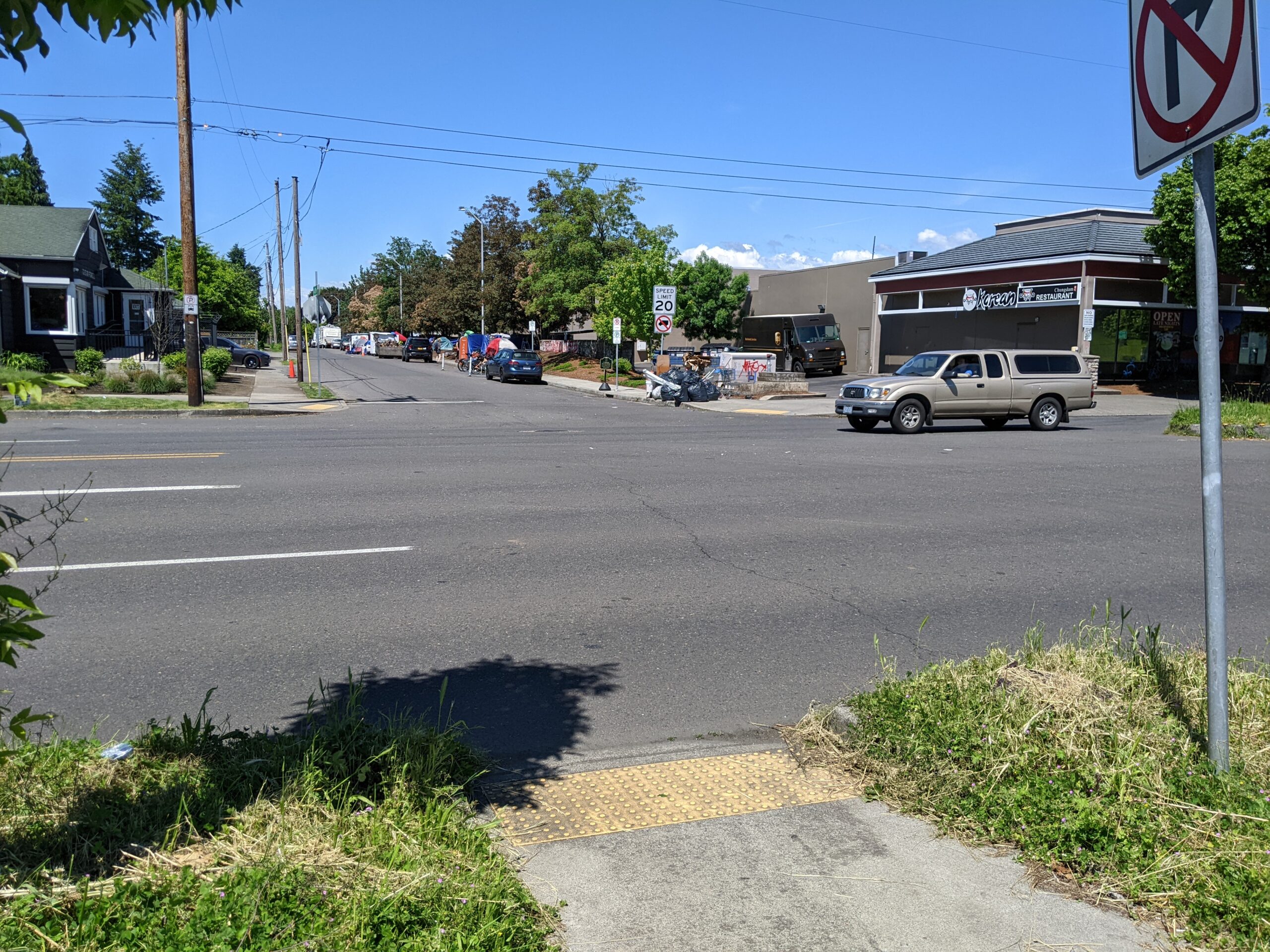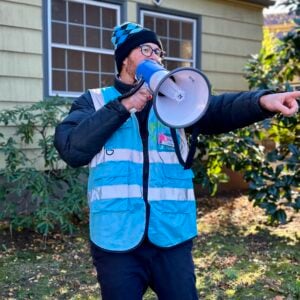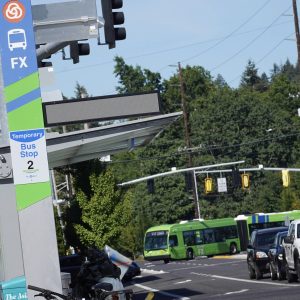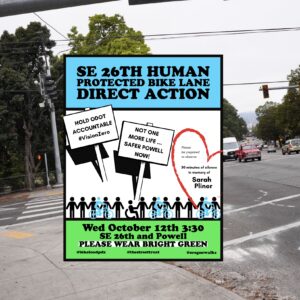
“Everybody’s going to have to drive their kids to school if they can’t walk safely.”
– Nearby resident
One nearby resident we spoke to (who asked to remain anonymous) says she moved to Portland in 2018 and settled with her husband and two young children in the Foster-Powell neighborhood near SE Powell Blvd and SE 79th Ave. Shortly after the move, she started to become concerned about the dangerous arterial she lived next to, seeing people driving much faster than the posted speed limit and inadequate facilities for people walking and biking to help them navigate this busy street.
She isn’t the only person concerned about safety on Powell Blvd. For many people who walk and bike around southeast Portland, crossing Powell is the most dreaded part of an otherwise pleasant trip. There are too few places to cross, and the crossings that do exist require people to cover a lot of ground in a short period of time. The city of Portland acknowledges Powell as one of its ‘high crash’ corridors, and people using all modes of transit are at high risk of getting into a traffic crash on this street, with people walking and biking especially vulnerable.
But an investigatory team of neighbors found TriMet has planned the safety improvements they’ve been clamoring for, they just haven’t built them yet. Advocates say they can’t afford to wait any longer.
Powell Blvd has historically been a difficult corridor to make safety changes to because it’s designated a state highway and therefore is under the jurisdiction of the Oregon Department of Transportation. People have long advocated for Powell to change ownership from the state to the City of Portland and there’ve been studies and even legislation legislation to make that reality. But it has yet to happen, and despite multiple ODOT-managed safety projects on Powell, people walking and biking are still at high risk of being hit by a driver and injured or killed.
When the woman who lives nearby realized how dangerous her new neighboring street was, she and her husband, along with other neighborhood advocates including John Carr, the Land Use Chair of the South Tabor neighborhood association, set out to see what local officials were doing about it.
TriMet’s plans for Powell

After a lot of research and months of back and forth between PBOT, ODOT and TriMet, they were able to get their hands on some TriMet project plans identifying planned safety improvements on Powell as part of a project called the Powell-Division Corridor Safety & Access to Transit Plan.
Through this plan, TriMet would add or make improvements to 11 crossings on Powell and Division from Cesar Chavez Blvd to NE Division at NE Roberts in Gresham, including one at Powell and 79th. From documents we obtained from TriMet, it appears this project was funded by ODOT’s Statewide Improvement Plan all the way back in 2013.
The plan is not the same as PBOT’s Powell-Division Transit and Development Project or TriMet’s Division Transit Project, both of which are much easier to find information about online. In contrast, it appears the only way to find out about the crossings on Powell is to reach out to TriMet directly. Pritchard told me the only public information he can find about these crossings on the internet is through a PBOT page archived on the Wayback Machine in 2019. Even so, TriMet officials maintain this project does exist and is still in the works.
In September 2019, Pritchard and his fellow advocates from the Foster-Powell and South Tabor neighborhood associations began email correspondence with TriMet officials.
“Now that it’s getting darker earlier and staying darker later, I am extremely concerned about the safety of this intersection. I feel unsafe crossing the street by myself and extremely unsafe crossing with my three year old daughter,” Pritchard wrote in an initial email to TriMet officials asking for assistance. He also mentioned concerns about the Lilac Meadows emergency family shelter on 79th and Powell, which had opened a few months prior, bringing even more children to an area with very few pedestrian safety facilities.
In response, TriMet officials told advocates the project would be underway in spring 2020. Two years later, however, construction still hasn’t begun, and people’s lives are at risk when they walk or bike across the street.
Stuck in bureaucratic purgatory
Throughout the years, as concerned neighbors have repeatedly checked in with TriMet officials via email and by speaking at board meetings, the agency has told concerned neighbors in the Foster-Powell and South Tabor neighborhood associations the project is delayed for a variety of reasons, and continuously pushing the timeline back. These include: potential conflicts with PBOT’s 70s Neighborhood Greenway project and procuring the right-of-way from neighboring property owners, as well as general pandemic-related delays.
But it seems the biggest hurdle has been accessing construction permits and project approval from ODOT and the Portland Bureau of Transportation. Because this project is 11 planned crossing upgrades lumped together, they have to get approval on all of the crossings before they can start building even one of them. People who have been advocating for these improvements have asked why TriMet can’t do one or two of these crossings at a time instead of waiting for project approval for the entire plan. But TriMet says it won’t be possible to divide the project further.
According to Tia York, TriMet’s Public Information Officer, this roadblock is ongoing, so the project will yet again be pushed back until next spring until they can get approval from all involved agencies. Given the history of delay, advocates are skeptical.
“Powell doesn’t have to be like this.”



In letters to the TriMet board, neighbors say the delays on this project will result in a ripple effect for nearby TriMet projects. If people can’t cross Powell safely, that’s going to limit their access to the long-awaited Division Transit Project .
Another reason residents and advocates are pushing TriMet to act urgently on these safety enhancements is because Portland Public Schools students in southeast Portland may be shuffled around as a result of boundary modifications. This could mean students in neighborhoods surrounding Powell Blvd who were previously going to school on one side of the corridor may now be required to cross the street to get to school.
Last month, students from Lent Elementary School held a protest walk to draw attention to the issue (see tweet at right).
“Everybody’s going to have to drive their kids to school if they can’t walk safely,” one parent told me.
Members of the surrounding neighborhoods express real fear about living next to such a busy street they think has been overlooked by local agencies and say they’re considering intensifying their approach. Residents said they are in contact with The Street Trust and are hoping to get more advocacy groups on board to add pressure.
“It’s so frustrating that this could be a solved problem,” one local mom said. “I just want more people to know that this is supposed to be happening and clamor for it to happen. Powell doesn’t have to be like this.”






Thanks for reading.
BikePortland has served this community with independent community journalism since 2005. We rely on subscriptions from readers like you to survive. Your financial support is vital in keeping this valuable resource alive and well.
Please subscribe today to strengthen and expand our work.
I appreciate the attention given to this stretch of Powell. I wrote to PBOT last year about the problematic exit from the shopping center at 80th. Lots of people are trying to turn left out of the shopping center to go east on Powell, but traffic is thick and fast. It’s a popular place to turn, and thus a dangerous place to cross.
Further, there’s no good place for a cyclist or pedestrian to cross in the stretch between 82nd and 72nd. There are no signals, and the only crosswalk, at 75th doesn’t have blinking lights, which often means that traffic in the lane closest to the curb will yield for a pedestrian, but inside lanes won’t see anyone crossing because their vision is blocked, and continue.
The 70’s greenway is simply cut here. There are markings on 79th north and south of Powell, but I’m not sure how PBOT intends for cyclists to cross.
You said “the only crosswalk”, but I think it’s worth pointing out that every intersection in Oregon, unless explicitly prohibited, is legally a crosswalk. And pedestrians have the right of way at every crosswalk, marked or unmarked. Now, with that said, crosswalks should be painted at every last intersection.
In my limited experience I find that the only places cars will routinely stop (not 100% of course) are stop lights and flashing lights at crosswalks. Anything else, painted or not, is ignored by large swaths of the driving population. Until the City does enforcement actions widely across the city and without prior notice to the new media then that’s likely not going to change.
I’ve noticed that cars turning onto the west bound Burnside Bridge respect the space of the adjacent raised bike lane because the mountable edge creates an off-camber slope. Could we start building intersections in such a way that vehicles making fast turns encounter an off camber? There’s some degree of pitch that is fully negotiable at a moderate speed but disconcerting at higher speeds. Most drivers will respect it and aggressive drivers will have to conform. A shallow speed bump that aggressive drivers push across is more effective if it’s asymmetrical.
I don’t see Jersey barriers as the answer to everything but we could place a few in the line that an errant driver would fall into if they corner too hard. A few warning signs wouldn’t hurt.
I have a 21-page pdf of the original $3 million TriMet STIP application, approved 11/27/2012. The project extended into East Portland and Gresham and eventually contributed to both the Division bus project and the outer Powell roadway rebuild, which likely explains why I have a copy of it. Let me know if anyone needs it.
Project Summary:
This project makes priority improvements for safety, access to transit and transit operations in the Powell and Division corridors, with current TriMet Frequent Service lines and a designated regional High Capacity Transit development corridor. It will focus on priority safety and access improvements identified by the project partners, adopted plans, and highlighted in TriMet’s Pedestrian Network Analysis. Improved safety, access, operations reliability and travel time provide immediate benefits and set the stage for future anticipated service increases in the corridor. Identified improvements could also be included in scope of potential Powell-Division On-Street Bus Rapid Transit project, which would present additional chance for using these STIP funds to leverage future improvements.
Has anyone tried contacting ODOT about Powell crossings? I seem to recall somewhere that ODOT owns Powell, but I could be mistaken…
The 2019 Inner Powell Report from ODOT mentions a SE Powell Boulevard High Crash Corridor Safety Plan – it apparently has a specific plan for SE 79th at Powell.
The Powell-Division Transit and Development Project is lead by Metro not PBOT. It is funded, clearly delayed by covid, and calls for RRFBs & Enhanced Crossings at 47th/48th, 57th, 61st, & 79th; crosswalk striping at 61st and 79th; pedestrian refuge islands at 47th & 79th; and various bus shelter improvements at 39th, 50th, and 82nd, according to ODOT.
The map on your article that you got from TriMet shows ODOT as the author.
Metro website: https://www.oregonmetro.gov/powell-division-transit-and-development-strategy
Note how you can hardly take a picture of Powell these days without a heap of garbage sneaking its way into the backround. Is it any wonder people drive so fast, and treat it like an area to avoid?
This is the kind of thing that trickles down to behavior. If it looks like nobody’s paying attention, like nobody cares, then it’s a lot easier for people to feel that it’s okay to speed and drive recklessly. Same thing all over Portland right now. We’ve been told that we have to accept a dingy, decrepit, abused carcass of a city.
Reckless driving rose all across the country over the last couple years (see link at bottom). If such driver behavior was truly caused by trash and a city’s image in the popular psyche, we wouldn’t see such a broadly distributed trend. NYC notoriously has a terrible trash pickup system—garbage and trash bags piled high up and down streets. Is NYC famous for its uncommonly high rate of speeding and reckless driving? I’ve been there and looks like gridlock to me.
Keeping a city clean and orderly, getting people affordably housed, etc are serious issues requiring urgent responses at multiple levels of government. But those issues and people are not to blame for the antisocial drivers and poorly designed infrastructure that make my stretch of Powell unsafe. ODOT and the drivers themselves are the ones accountable.
https://crashstats.nhtsa.dot.gov/Api/Public/ViewPublication/813199
FAULTY LOGIC ALERT!!! BLEEP!!!
Claim: Trash leads to speeding
Challenge: NYC has lots of trash and is not known for speeding*, as evidenced by the gridlock the challenger has seen there**.
Logical Problem: Gridlock is caused by the number of vehicles exceeding the local capacity of a street network, not by people driving slowly despite the presence of trash. If trash did indeed cause speeding, NYC would still suffer from gridlock because it has a different cause. The cited evidence has no bearing on the claim being tested.
And Also: “Drivers are the ones accountable.” Of course they are, but that also has no bearing on the claim being challenged. Trash could signal to people that they’re unlikely to be ticketed for speeding, but no one claims that excuses the behavior, or that people who drive are not to blame. People operating vehicles are responsible for following the law, regardless of whether there is trash present or how the street is designed.
And Finally: The challenge concludes by assigning blame to ODOT for speeding drivers; this is no different than blaming the presence of trash. Drivers are responsible for their behavior, no one else.***
*I don’t know that NYC is NOT known for speeding, but testing the veracity of this assertion is not necessary for this FLA.
**Likewise, we can ignore the anecdotal nature of the “evidence” presented.
***Of course ODOT should design roads to encourage people to drive safely. We should also pick up the trash that encourages people to drive too fast.
Love it Watts! FAULTY LOGIC ALERT?
I keep finding myself in the role of NYC interpreter. As I remember (and it’s been 20 years) Manhattan trash was picked up twice a week. The maintenance staff for every building put the trash out on the sidewalk the night before. So, yes, there was a ton of bags of trash on the sidewalk the night before—these are really tall buildings! But it was picked up the next morning.
Otherwise, Manhattan has gotten really clean over the past couple of decades, kind of antiseptic, practically a theme park! LOL. Also, crime is really low after peaking in the early 90s. All in all, a clean, safe place to live.
Bike Portland reported on a future “beg button” at this location 2 or 3 years ago and I have waited anxiously for it. Foster has two of these in the same stretch and they work great in my opinion. I cross Powell at the crosswalk at 75th and more often than not, my crossing happens because traffic lights luckily matched up in both directions and created a brief pause in traffic. Seems like even if it wasnt the long term solution, a beg button could be installed. How many hours would it take to install such a thing, six or seven hours?
I just had an online conversation this morning with our city engineer here in Greensboro NC about a beg button being installed on a completely different street, on an 8-way 8-lane intersection that makes 79th & Powell look like a minor street intersection, including a major US highway (Cornwallis @ Battleground). His response was probably what you’ll get from ODOT: adding a beg button will mess up the traffic flow and the signal cycle – you know, end life as we know it…
An honest solution consistent with our current use of technology would be to run a shuttle van to transport pedestrians from point to point around the intersection. It would take about 11 minutes to cross the street but you’d be safe, which we define as “inside a motor vehicle.”
Plus it would raise our paltry transit ridership numbers and encourage transfers between buses! A total win-win for everyone involved!
They should have finished the mount hood hwy decades ago as promised. Portland has continued to take the tax money from SE and redistribute it elsewhere while SE falls apart. I have ZERO faith that they will suddenly start doing real improvement.
It’s time to block that intersection, at least twice a week until the people’s voice be heard.
How about installing sidewalks east of 136th?no people on Mars first…